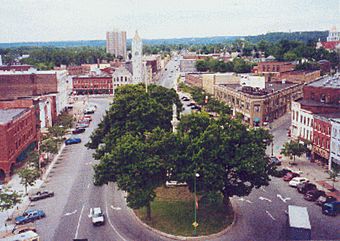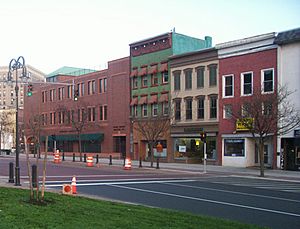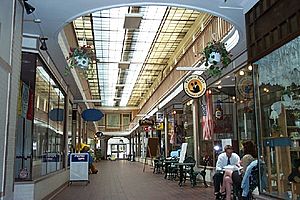Public Square (Watertown, New York) facts for kids
|
Public Square Historic District
|
|

Aerial view of Public Square.
|
|
| Location | Roughly Court, Arsenal, Washington, Franklin and State Sts., Watertown, New York |
|---|---|
| Area | 16 acres (6.5 ha) |
| Built | 1805 |
| Architect | Augustus Saint-Gaudens; Multiple |
| Architectural style | Late 19th And 20th Century Revivals, Late Victorian, Art Deco |
| NRHP reference No. | 84002409 (original) 16000110 (increase) |
Quick facts for kids Significant dates |
|
| Added to NRHP | September 7, 1984 |
| Boundary increase | March 22, 2016 |
Public Square is an open area in the middle of Watertown, New York. It's like a big town square. This square is special because it's listed as the Public Square Historic District on the National Register of Historic Places. This means it's an important historical place. The district includes 58 important buildings, one site, and three objects that help tell its story.
Contents
Exploring Public Square
Public Square has a rectangular shape. Buildings stand all around its four sides. In the very center, there is a large oval park. Cars drive in one direction around this park.
Many of Watertown's main roads meet at the square. This includes important routes like U.S. Route 11 and New York State Route 3. Because of this, many cars pass through Public Square every day.
While some buildings are modern, most of the square looks old. It has many buildings from the 1800s and early 1900s. You can find all sorts of places here. There are shops, restaurants, offices, churches, and apartments. This makes Public Square a busy spot for shopping and business in Watertown.
History of Public Square
The first people to settle in Watertown built their homes here in 1800. This was on what is now the west side of the square. In 1805, some settlers gave land for everyone to use. This land became the start of Public Square. It quickly grew into Watertown's main business area. The way the square and its streets look today began in those early years.
Fires and Rebuilding
In 1849, a big fire destroyed most of Public Square. Many buildings on nearby streets were also burned. But the square was rebuilt right away. Some of the buildings put up after that fire are still standing today. In the 1850s, the city made three parks in the center of the square. A fountain was placed in the middle park.
Growth and Change
Watertown grew a lot in the late 1800s and early 1900s. This was a time of industrial boom. Public Square became the heart of the city. It was the main place for shopping, business, and social life. In the 1950s, the three parks in the center were joined into one big park.
The Soldiers and Sailors Monument was added in 1891. This monument honors soldiers and sailors.
Decline and Renewal
In the second half of the 1900s, Public Square became less important for shopping. City plans in the 1960s and 1970s led to some old buildings being torn down. This was part of a process called urban renewal. It aimed to modernize cities.
Watertown's economy also slowed down. New shopping malls were built outside the square. These malls drew businesses away. Public Square was no longer the city's main shopping spot. The square slowly continued to decline for about 20 years.
Public Square Today
At the start of the 2000s, people began to care more about Public Square. There was a new sense of pride in its history. City and business leaders worked hard to make it better. Old buildings were fixed up, and new businesses moved in. Some very old buildings that could not be repaired were taken down.
In 2006, a big project started to improve the square. It cost millions of dollars. This project fixed roads, walkways, and added new landscaping. It made the square's basic structures stronger and more beautiful. The project finished in November 2008.
Famous Connections at Public Square
Public Square has been home to many interesting people, buildings, and inventions.
- Augustus Saint-Gaudens was a famous sculptor. In 1902, he designed a monument for New York Governor Roswell P. Flower. This monument is a key sight on Washington Street.
- The Paddock Arcade is located here. It was built in 1850. People say it is the oldest covered shopping mall in the United States that has been open all the time. It is also listed separately on the National Register of Historic Places.
- The abolitionist Frederick Douglass visited Public Square in the 1850s. He spoke at Washington Hall. He also stayed at the famous Woodruff Hotel. Hotel managers wanted him to use a back entrance. But he insisted on using the front door and eating in the public dining room. He stood up against unfair treatment.
- Frank Winfield Woolworth worked as a clerk in a department store on Public Square in the 1870s. He had an idea to sell items for just five or ten cents. This idea was very popular. It inspired him to open his own store. This was the start of the famous Woolworths chain of department stores.
- Julius Sämann invented the Little Trees car air freshener in the 1950s. He created it in the Electric Building on Public Square. These air fresheners look like small pine trees. They hang from car mirrors and are known all over the world. The company that makes them still has its main office and a factory in Watertown.








